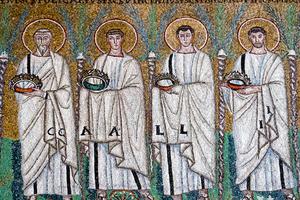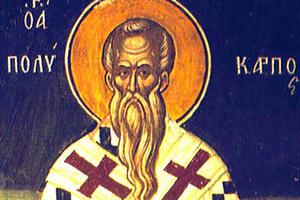St. Polycarp is the Saint of Connections
St. Polycarp of Smyrna, pray for us

Poor St. Polycarp! Despite being a disciple of St. John the Evangelist himself and suffering a true martyr’s death — recounted in great gory (yet glorious) detail —absolutely no one names their child after him. Perhaps this is not too surprising in that his name sounds like a school of bottom-feeding fish. But on this day when we remember him, we should be grateful for such a great saint.
St. Polycarp was born circa 69, but we know little else of his childhood and youth. That he was a member of that small band of “Apostolic Fathers” — those immediate followers of the Apostles themselves—there has never been any doubt, and in Polycarp’s case he was a disciple of St. John, the “Beloved Disciple” of Jesus Himself. Indeed, a letter from St. John to Polycarp has survived. Soon after the death of St. John, Polycarp was named the Bishop of Smyrna (now Izimir, Turkey).
They say that in life it’s not what you know but who you know, and this was true in Polycarp’s case as well. In addition to learning the Christian Faith personally from St. John, we know that Polycarp actually kissed the chains of the great St. Ignatius, Bishop of Antioch as the latter passed by Smyrna en route to martyrdom. St. Ignatius also wrote a letter to Polycarp which is still extant. Further, Polycarp in turn instructed St. Irenaeus (famous for his work Against Heresies) and Papias of Hierapolis, the important early Scripture scholar who had a profound effect on Eusebius and Hippolytus. Finally, Polycarp traveled all the way to Rome to meet with Pope St. Anicetus to work out when, exactly, Easter should be observed each year. It is a tribute to both saints that, despite the fact that they could not agree on when Easter should be celebrated, that they respected each other’s decision, and the pope was so impressed with Polycarp that he asked him to celebrate Holy Mass in his own papal church.
Polycarp was an indefatigable defender of the orthodox faith especially against the heresies known as Valentinianism and Marcionism, both of which were types of Gnosticism, and he was renowned for his letter-writing, especially his Letter to the Philippians (though St. Irenaeus mentions several others).
If he had done nothing else, Polycarp would have been worthy of Church history books as an “Apostolic Father,” a disciple of St. John, a defender of orthodoxy, the bishop of Smyrna, the friend of Ignatius of Antioch and Pope Anicetus, teacher and letter-writer and a sort of bridge between the Eastern and Western Churches. But Polycarp’s legacy — and legend — would be forever cemented by his martyrdom.
Polycarp’s death is important for a couple of reasons: first, it is the oldest authentic example of the “acta” of a Church martyr (as opposed to pious legends that sprang up later). Second, the account of his death really reads — even today! Though there are many variations on the actual events, I defer to the immortal Alban Butler to recount the martyrdom of St. Polycarp:
In the sixth year of Marcus Aurelius (according to Eusebius) a violent persecution broke out in Asia in which the faithful gave heroic proof of their courage. The holy man, Polycarp, though fearless, had been prevailed upon by his friends to conceal himself during the storm. When the persecutors came in search of him he changed his retreat, but was betrayed by a slave, who was threatened with the rack unless he disclosed Polycarp’s whereabouts. When the chief of police, Herod, sent horsemen by night to surround his lodging, Polycarp was upstairs in bed, but refused to make his escape saying, ‘God’s Will be done.’ He went down, met them at the door, ordered them supper, and desired only some time in prayer before he went with them.The holy man went cheerfully to the place where the people were assembled. He was led to the tribunal of the proconsul, who exhorted him to have regard for his age [Polycarp was about age 86!], to swear by the genius of Caesar, and to say, ‘Away with the atheists’, meaning ‘The Christians.’ The saint, turning toward the crowd of ungodly people in the stadium, said, with a stern countenance, ‘Away with the atheists!’ The proconsul repeated, ‘Swear by the genius of Caesar and I will discharge you: revile Christ.’ Polycarp replied, ‘Fourscore and six years have I served Him and He hath done me no wrong. How then can I blaspheme my King and my Savior? If you require me to swear by the genius of Caesar, as you call it, hear my free confession: I am a Christian and if you desire to learn the doctrines of Christianity, appoint a time and hear me.’ The proconsul said, ‘Persuade the people!’ The martyr replied, ‘I address myself to you; for we are taught to give due honor to princes, so far as consistent with religion. But before these people I cannot justify myself.Whilst Polycarp said this and many other things, he appeared in a transport of joy and confidence, and his countenance shone with a certain heavenly grace, insomuch that the proconsul himself was struck with admiration. However, he ordered a crier to announce three times in the middle of the stadium, ‘Polycarp hath confessed himself a Christian.’ At this the whole multitude appealed to Philip the governor to let a lion loose upon Polycarp. He told them that it was not in his power, because he had brought the sports to a close. Then they all clamored that he should be burnt alive. Their demand was no sooner granted than everyone ran with all speed to fetch wood from the bath-furnaces and workshops. The executioners would have nailed him to the stake but Polycarp said, ‘Suffer me to be as I am. He who gives me grace to endure the fire will enable me to remain at the pile unmoved.’ They therefore contented themselves with tying his hands behind his back.The flames, forming themselves like the sails of ship swelled with the wind gently encircled the body of the martyr which stood in the middle, resembling not burning flesh but bread that is being baked or precious metal refined. And there was a fragrance like the smell of incense. The order was given that Polycarp should be pierced with a spear, which was done: and a dove came forth and such quantity of blood as to quench the fire.Nicetas advised the proconsul not to give the body to the Christians, lest, he said abandoning the crucified man they should worship Polycarp. The centurion placed the body in the middle and burnt it to ashes. It was at two o’clock in the afternoon on Feb. 23 about the year 155.
Prior to the Second Vatican Council, St. Polycarp’s feast day was observed on Jan. 26: since then it has been moved to February.
- Keywords:
- st. polycarp
















